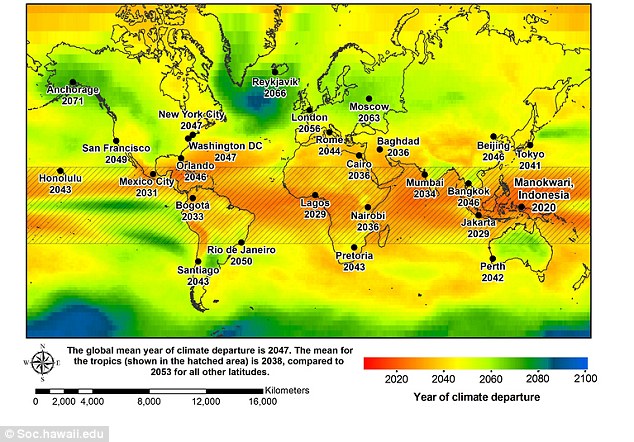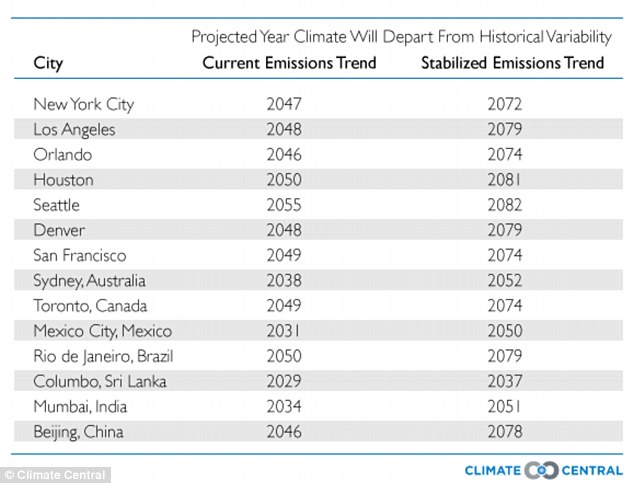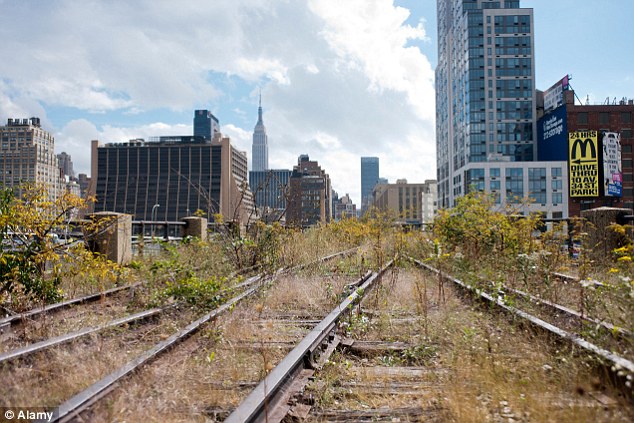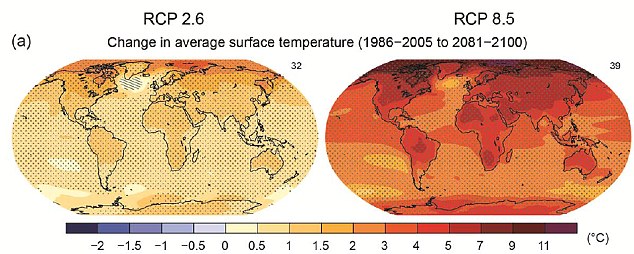Apocalypse Imminent: Climate Crisis Will Turn To Reality By The End Of The Decade
By Countercurrents.org
10 October, 2013
Countercurrents.org

The cities to be hit first, and the year it will begin, by irrevocable climate crisis if nothing is done to stabilize GHG emissions
The researchers say the tropics will bear the brunt of the disastrous temperature increases of as much as seven-degrees-centigrade as the region will be the first to exceed the limits of historical extremes and experience an unabated heat wave that threatens biodiversity and heavily populated countries with the fewest resources to adapt. Millions of people will be displaced; millions of species will be threatened with extinction.

Frightening Projections: The unprecedented heat starts in 2020 with Manokwa , Indonesia , to be followed by Kingston , Jamaica . Within the next two decades, 59 cities will be living in what is essentially a new climate including Singapore , Havana , Kuala Lumpur and Mexico City .
Within 35 years, even the lowest monthly dips in temperatures will be hotter than we've experienced in the past 150 years, according to the new and massive analysis of all climate models.

Apocalyptic Future: By 2046, New York and Washington will get the coldest year and will be hotter than the hottest year in its past
Ecological and societal disruptions by modern climate change are critically determined by the time frame over which climates shift. Camilo Mora and colleagues in the College of Social Sciences ' Department of Geography at the University of Hawaii , Manoa have developed one such time frame.
The study "The projected timing of climate departure from recent variability," published in the October 10 issue of Nature provides an index of the year when the mean climate of any given location on Earth will shift continuously outside the most extreme records experienced in the past 150 years.

An abandoned Trafalgar Square in London
The new index shows a surprising result. Areas in the tropics are projected to experience unprecedented climates first -- within the next decade. Under a business-as-usual scenario, the index shows the average location on Earth will experience a radically different climate by 2047. Under an alternate scenario with greenhouse gas (GHG) emissions stabilization, the global mean climate departure will be 2069.

Future Planet: These projections of global temperature change based on two different climate scenarios show the world from 1986-2005 and what could unfold at the end of this century with a rise in average temp from 32 to 39 degrees centigrade
"The results shocked us. Regardless of the scenario, changes will be coming soon," said lead author Camilo Mora. "Within my generation, whatever climate we were used to will be a thing of the past."
The scientists calculated the index for additional variables including evaporation, precipitation, and ocean surface temperature and pH. When looking at sea surface pH, the index indicates that we surpassed the limits of historical extremes in 2008. This is consistent with other recent studies, and is explained by the fact that ocean pH has a narrow range of historical variability and because the ocean has absorbed a considerable fraction of human-caused CO 2 emissions.
The study found that the overarching global effect of climate change on biodiversity will occur not only as a result of the largest absolute changes at the poles, but also, perhaps more urgently, from small but rapid changes in the tropics.
Tropical species are unaccustomed to climate variability and are therefore more vulnerable to relatively small changes. The tropics hold the world's greatest diversity of marine and terrestrial species and will experience unprecedented climates some 10 years earlier than anywhere else on Earth.
The study suggests that conservation planning could be undermined as protected areas will face unprecedented climates just as early and because most centers of high species diversity are located in developing countries
Rapid change will tamper with the functioning of Earth's biological systems, forcing species to either move in an attempt to track suitable climates, stay and try to adapt to the new climate, or go extinct.
"This work demonstrates that we are pushing the ecosystems of the world out of the environment in which they evolved into wholly new conditions that they may not be able to cope with. Extinctions are likely to result," said Ken Caldeira of the Carnegie Institution for Science's Department of Global Ecology, and who was not involved in this study. "Some ecosystems may be able to adapt, but for others, such as coral reefs, complete loss of not only individual species but their entire integrity is likely."
These changes will affect our social systems as well. The impacts on the tropics have implications globally as they are home to most of the world's population, contribute significantly to total food supplies, and house much of the world's biodiversity.
In predominately developing countries, over one billion people under an optimistic scenario, and five billion under a business-as-usual-scenario, live in areas that will experience extreme climates before 2050.
This raises concerns for changes in the supply of food and water, human health, wider spread of infectious diseases, heat stress, conflicts, and challenges to economies.
"Our results suggest that countries first impacted by unprecedented climates are the ones with the least capacity to respond," said coauthor Ryan Longman, a graduate student at the University of Hawaii .
"Ironically, these are the countries that are least responsible for climate change in the first place."
"This paper is unusually important. It builds on earlier work but brings the biological and human consequences into sharper focus," said Jane Lubchenco, former Administrator of the National Oceanic and Atmospheric Administration and now of Oregon State University , who was not involved in this study. "It connects the dots between climate models and impacts to biodiversity in a stunningly fresh way, and it has sobering ramifications for species and people."
While the study describes global averages, the authors have visualized their data on an interactive map displaying when climate will exceed historical precedents for locations around the world.
"We hope that with this map people can see and understand the progression of climate change in time where they live, hopefully connecting people more closely to the issue and increasing awareness about the urgency to act," said coauthor Abby Frazier.
The index used the minimum and maximum temperatures from 1860-2005 to define the bounds of historical climate variability at any given location. The scientists then took projections for the next 100 years to identify the year in which the future temperature at any given location on Earth will shift completely outside the limits of historical precedents, defining that year as the year of climate departure.
The data came from 39 Earth System Models developed independently by 21 climate centers in 12 different countries. The models have been effective at reproducing current climate conditions and varied in their projected departure times by no more than five years.
The study suggests that any progress to slow ongoing climate change will require a larger commitment from developed countries to reduce emissions, but also more extensive funding of social and conservation programs in developing countries to minimize climate change impacts. The longer we wait, the more difficult remediation will be.
"Scientists have repeatedly warned about climate change and its likely effects on biodiversity and people," said Mora. "Our study shows that such changes are already upon us. These results should not be reason to give up. Rather, they should encourage us to reduce emissions and slow the rate of climate change. This can buy time for species, ecosystems, and ourselves to adapt to the coming changes."
Humanitarian crisis could unfold, as hundreds of millions of global warming refugees pour illegally across borders fleeing the consequences of the scorching temperature rises which might leave entire regions of the planet extinct of life.
And while the doomsday clock is ticking, with the first signs of change expected at the end of this decade, researchers of the study claim that it is too late to reverse and mankind needs to prepare for a world where the coldest years will be warmer than what we remember as the hottest.
The study predicts that even if we utilized all resources to stop and halt our current emissions, the changes are irrevocable and can only be postponed.
All things remaining the same, New York City will begin to experience dramatic, life altering temperatures by 2047, Los Angeles by 2048 and London by 2056.
However, if harmful greenhouse emissions are stabilized, New York would be able to stave off the inevitable changes until 2072 and London until 2088.
The first US cities to feel the changes would be Honolulu and Phoenix , followed by San Diego and Orlando , in 2046. Washington will get new climates around 2047, with Detroit , Houston , Chicago , Seattle , Austin and Dallas a bit later.
Mora calculated that the last of the 265 cities to move into their new climate will be Anchorage , Alaska — in 2071. There's a five-year margin of error on the estimates.
The current projections predict that the epicenter of global warming will be at the tropics which will bear the brunt of the initial changes, with temperature rises beginning in or around Manokwari , Indonesia by 2020. Manokwari is directly on the Equator.
'We are used to the climate that we live in. With this climate change, what is going to happen is we're going to be moving outside this comfort zone,' said Mora.
'Countries first impacted by unprecedented climate change are the ones with the least economic capacity to respond. Ironically, these are the countries that are least responsible for climate change in the first place,' said Longman.
'By expanding our understanding of climate change, our paper reveals new consequences for biodiversity and highlights the urgency to take action now.'
The study shifts the way in which climate scientists have been examining the implications of GHG emissions.
While most have focused on the rapidly warming climate in the Arctic and the effects on wildlife such as polar bears and also sea levels, Mora's team are concerned with the effects on people - specifically the tropics - where the majority of the world's population lives and whose citizens have contributed the least to global warming.
It is in the already warm tropics that an increase of only a couple of degrees can alter the balance of life, crippling crops, spreading disease and leading to mass migration away to cooler climes.
The study says by the year 2047, every year that follows will probably be hotter than that record-setting scorcher.
Eventually, the coldest year in a particular city or region will be hotter than the hottest year in its past.
Mora, in a briefing with reporters on Tuesday, said if mankind continued to burn fossil fuels, the threshold for the planet as an average globally is 2047 - with temperatures rising by as much as seven degrees centigrade.
If GHG emissions are stabilized, this date is delayed only by 20 years, as an average.
But, those extra 20 years bought through emissions cuts could prove crucial for many species' survival, Mora said.
'Imagine you are on a highway, and you spot an obstacle in the road up ahead,' Mora said.
'Should you step on the gas, or hit the brake?'
'Hitting an obstacle at a slower speed will minimize the damage to the car and its occupants, in much the same way as hitting a climate threshold at a slower speed would reduce the ramifications for biological systems.
'The speed at which you face that obstacle is going to make a huge difference.'
Mora admits that his study is subject to geographic variables, saying that the changes he is predicting will not occur at the same time across the world.
Mora's research has led him to the conclusion that all the species in any of the regions affected by adverse temperature rises have three stark choices.
Either they move to a cooler climate, adapt to the warmer climate or become extinct.
However, this is where conflict could arise amongst nations as desperate and starving people try to migrate en-mass north or south to escape the arid land they have come to live in.
'We have these political boundaries that we cannot cross as easily. Like people in Mexico — if the climate was to go crazy there, it is not like they can move to the United States ,' said Mora to NBC News.
The Mora team found that by one measurement — ocean acidity — Earth has already crossed the threshold into an entirely new regime. That happened in about 2008, with every year since then more acidic than the old record, according to study co-author Abby Frazier.
Of the species studied, coral reefs will be the first stuck in a new climate — around 2030 — and are most vulnerable to climate change, Mora said.
Pennsylvania State University climate scientist Michael Mann said the research 'may actually be presenting an overly rosy scenario when it comes to how close we are to passing the threshold for dangerous climate impacts.'
'By some measures, we are already there,' he said.
* Story Source:
The story is based on materials provided by University of Hawaii at Manoa , via EurekAlert!, a service of AAAS.
Journal Reference :
Camilo Mora, Abby G. Frazier, Ryan J. Longman, Rachel S. Dacks, Maya M. Walton, Eric J. Tong, Joseph J. Sanchez, Lauren R. Kaiser, Yuko O. Stender, James M. Anderson, Christine M. Ambrosino, Iria Fernandez-Silva, Louise M. Giuseffi, Thomas W. Giambelluca. The projected timing of climate departure from recent variability . Nature , 2013; 502 (7470): 183 DOI: 10.1038/nature12540
Source:
University of Hawaii at Manoa (2013, October 9). Urgent new time frame for climate change revealed by massive analysis. ScienceDaily . Retrieved October 10, 2013 , from http://www.sciencedaily.com /releases/2013/10/131009133216.htm, and Mail Online, James Nye, October 10, 2013 , http://www.dailymail.co.uk/news/article-2451604/Apocalypse-Now-Unstoppable-man-climate-change-reality-end-decade-make-New-York-London-Paris-uninhabitable-45-years-says-new-study.html
Comments are moderated
